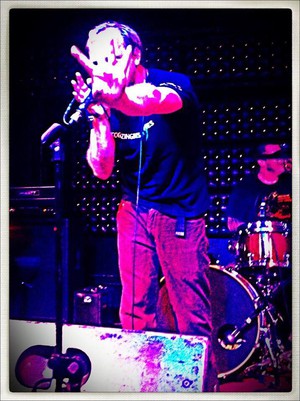McEric chats with Director Darren Lynn Bousman about ST. AGATHA
Horror director Darren Lynn Bousman has been splattering blood on the screen for almost fifteen years, and if that’s your bag, then you’ve undoubtedly seen one or several of his features. Most notable for directing SAW II, III, and IV, he also holds the distinction of writing the second installment and creating what is known of the franchise’s deviant mastermind, Jigsaw.
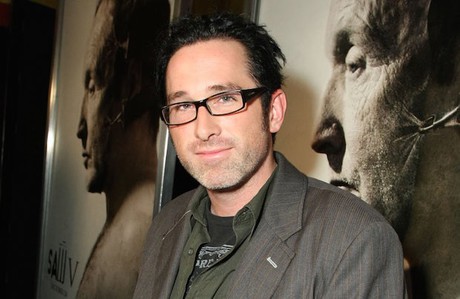
Bousman’s newest film is a tension-filled slow-boiler set in 1957 following an unwed expectant mother, Mary Lou, as she seeks asylum in a convent in Georgia. Once there she discovers that things are not as they seem, and God may not reside in every house that bears His name.
I got the chance to chat with Bousman about the new film, what he’s been up to the past few years, and what he has on the horizon.
Darren Lynn Bousman: Hey, man.
McEric: Hey, how are you today?
DLB: Doing well, man. How about yourself?
ME: I’m doing all right. I’m a little under the weather but it was unavoidable.
DLB: Ah shit. Sorry to hear that.
ME: Oh, I’ll live. So, actually, this is great timing: I just finished watching ST. AGATHA and I guess the first burning question in my mind is, with a horror resume as impressive as yours, why did you choose [to make] this film?
DLB: You know, it was funny, I took a break from making films for a year and a half and I was doing immersive theatre. I do this thing called THE TENSION EXPERIENCE, which is like… Have you ever seen THE GAME? It’s like what happened to Michael Douglas-
ME: Oh yeah; the Fincher film.
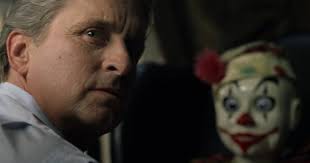
DLB: Exactly. So, we’ve been doing this and it’s this insane [experience]. It could not be any more different from making movies than you could possibly get. So I was doing THE TENSION EXPERIENCE and I was working with Sabrina Kern who was the lead in that. A kind of backstory first off about her, who plays ST. AGATHA: she’s Swiss-German, and she’d just moved here from Switzerland and she was the lead in THE TENSION EXPERIENCE and she would joke with me asking “How did you get involved in the SAW movies? How do you get into movies?” And I kind of joked and said “It’s a really hard, uphill battle. It’s a Catch-22” and we were talking, then at the same time a line producer on THE TENSION EXPERIENCE sneaked a script into my bag. Now, I hate reading scripts. Literally, I’ve walked on so many movies because I refused to read the script. I just don’t have the attention span. So he kept asking me “Hey, did you look in your bag? Did you look in your bag?” and finally one day I’m at home and I open up my bag and I see this script called ST. AGATHA. I flip it open and the original draft was much more vicious and violent; it was actually repulsive, the viciousness of it. And I’m reading it with this look of glee on my face thinking ten years ago I would’ve made this movie, but it was literally some things that people don’t want to see on screen. However, it had this great central character in St. Agatha and it had a great villain, and those are the two things that I always look for.
I think more than anything, it’s “Is the villain good?” If you look at some of the greatest horror movies, it’s all about the villain. Now I’ve been very lucky to be able to work with Jigsaw and Tobin Bell (SAW I-VIII) in creating an iconic villain and I was able to work with Rebecca De Mornay (THE HAND THAT ROCKS THE CRADLE) in MOTHER’S DAY, another great iconic villain. I read this and I saw Mother Superior as another one of those very cool, iconic villains and at the same time I found a great entry point for Sabrina Kern to kick off into film. So, ironically, it is Sabrina’s very first movie; very first English film, at all. And the whole thing came together very quickly: I ended THE TENSION EXPERIENCE, I told the line producer I’ll do it, and I was literally on a plane a month later with half the cast of THE TENSION EXPERIENCE in Atlanta making this film. And that’s another thing: the older I get, I don’t have patience or tolerance for years of development and what was great about this movie is that it was literally “Let’s go! We’re shooting next week.” And that’s what it was: I got the script in November and I was shooting it literally two months later, which is almost unheard of in L.A.
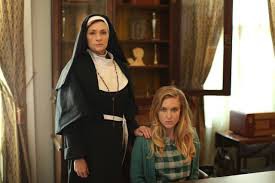
ME: Yeah, that is an amazing start time. You really hit the ground running. Now, you say this is Sabrina’s first English-language film. Did she do any film in Switzerland?
DLB: Actually, no. This is her first film, altogether. And I love crazy stories about people coming together, and what was really funny about her is just the randomness of how we met. And this is great: I love stories about How do Things Come to Be in Hollywood. Well, with her I was casting for, literally, a background extra in this immersive theatre production that I was doing and I put a blind ad out on Backstage. Backstage is the kind of place where people go if they’re looking to be cast in some of the smaller independent films. She responded to the ad and had no idea who I was, anything like that. I scheduled a meeting with her and I didn’t use my name; I think I actually ended up using a fake name because I didn’t want people to know that I was doing this. So we met for coffee and then she realized I was the director of the SAW films and she pulled out her cellphone and says “Oh my God, look who I was for Halloween last year”. She opens up her cellphone and she was the puppet. So we immediately hit it off and I thought she was charming and passionate and her little cameo turned into the lead of THE TENSION EXPERIENCE which was this year-long crazy thing that took place in L.A. that the Russo Brothers, who did THE AVENGERS, just purchased. They became our partners on THE TENSION EXPERIENCE in moving it to the next level. So, I met her that way, and… You asked me a question and there’s a reason I’m telling this story. Remind me of the question, because I just went off on this tangent about how I met the great Sabrina Kern…
ME: Basically I was just getting clarification that this is her first film because she’s riveting in it.
DLB: Oh yeah; that was the thing. She’d done a couple of music videos that she sang in and she’d done one or two short films and that was it. I joked with her when I asked her to be in the movie, saying, “Look, you’re going from never being in a movie to being the title of the movie. Are you ready for this?” Talk about Trial By Fire. I mean, we just threw her in, and she was fantastic. And that’s how Sabrina came to be.
ME: Well, she is amazing anchoring the film as St. Agatha. She runs the entire emotional gamut; it’s a bit of a Masters Course as a first outing, so kudos to her on that.
DLB: I agree. What makes it great is it’s the Yin and the Yang that makes it so exciting for me. With Mother Superior, Carolyn Hennesy is a fucking evil bitch and I love her so much ‘cause she’s so fun to watch. When I met Caroyln I wasn’t familiar with her work at all; she’s won, I don’t know, like a bazillion Daytime Emmys for her work on “General Hospital” and I sat down and met her over coffee. And it’s funny because when I met her I had the same feeling talking to her as the very first time I talked to Tobin Bell. She almost pierces into your soul and she terrified me. So I immediately I knew “Okay, she’s going to be fucking awesome.” So we’d cast Sabrina first and then we ended up casting Carolyn and then we cast the other girls very quickly after that. But I think that Carolyn Hennesy has such an amazing villainous presence in this.
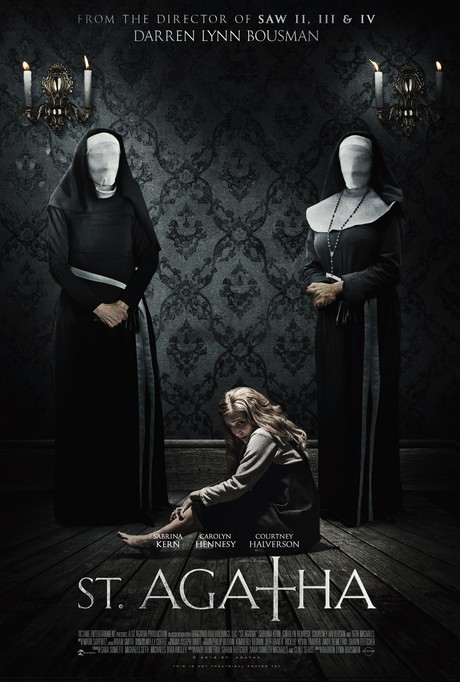
ME: Absolutely. I have a question about the composition of the film: I noticed you started with a coffin scene, creating the isolation, torture, and deprivation of Mary, so it starts en media res and then you go back to the beginning and rocket past that and that’s when we see some of the more violent aspects of the film. What tone were you hoping to set with that composition?
DLB: So, like any movie, the movie is done multiple times: there’s the movie you have in your head, the movie the script becomes, what you shoot, and then finally what the movie becomes in editing. The movie was obviously not written that way at all; it became that in editing. This was actually a tricky film to edit, for numerous reasons. One, this is the smallest film I’ve ever done, and what that meant to me was having to shoot the film in seventeen days when I usually have twenty or twenty-one. Now that might not seem like a big difference but it is, for me anyway. I struggled a lot having to move that quickly, and that’s why I have mad respect for these people who I hear made a movie in like sixteen, seventeen days. It was an extreme challenge. I got into the editing room and I noticed the stuff we shot very early on, and we shot the movie in continuity, wasn’t really working the way I wanted it to work. And what happened was, in the first edit of the film, you didn’t get to the convent until forty-five minutes in. It was way, way too long, and in that time, you hadn’t met Mother Superior. So the editor and myself sat down said “Okay, how can we bring this in much, much quicker?”
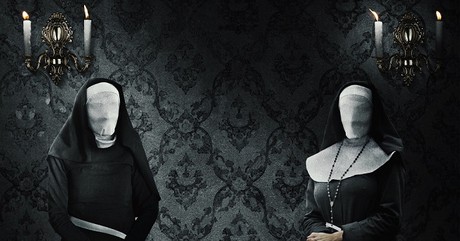
So we decided to try a non-linear approach to it where the flashbacks were kind of paralleling what she was going through. Which allowed us to get into- and this is the reality: when you have Darren Bousman’s name on a movie, you’re not expecting a drama. You want to see violence, you want to see that thing that I brought with SAW. And so in the original cut of the movie it was fifty-one minutes before anything even remotely like that happened. So we decided to take a different approach and kind of tell the movie in this non-linear aspect. So it leads, or at least assures the audience “Don’t worry: it’s gonna get fucked up. We’re gonna cut tongues out and strangle people with horrible objects. Give us some time.” So we restructured the movie in that respect to start with some more claustrophobic aspects to let the audience know “Hey, it’s coming. Don’t worry.”
ME: I do think it’s relevant you’re doing this film coming off the heels of something called THE TENSION EXPERIENCE. The pacing and tension in this film are ratcheted up impressively, more so than in the SAW films where there was a backstory laid and you knew who the villain was, mostly. In this one, you focus on building tension and creating the villain in Mother Superior. Tell me a bit more about that experience.
DLB: Well, one of the things I try to do in my career, whether I’m successful in it or not, is not rely solely on the gags and the gimmicks. As I mentioned earlier, it’s important to let the audience know they’re coming, but I’m hopefully a bit more reserved in my approach. Not being as bombastic and in your face. If you go back and look at SAW II, III, IV, and even REPO! [THE GENETIC OPERA], there are these in your face explosions of colors and screams and sounds, loud noises and that was me just not being confident and not really knowing what I was doing. I mean, listen, I’m fucking fourteen films in and I still have no idea what I’m doing but I think with ST. AGATHA we wanted to take more of a slow approach to it. We wanted to get the chance to know these people and let them actually build up the sinister nature. I think if you start off with Mother Superior being just batshit crazy and all the girls freaking out, crying, there’s nowhere to go. And so for us we really wanted to give it time and let some of the tension build; again, never really having done that before because I just hadn’t been confident that early in my career and never allowed that to happen. With this I had a little more freedom because it was an independent film, to give it more time and let the tension build.
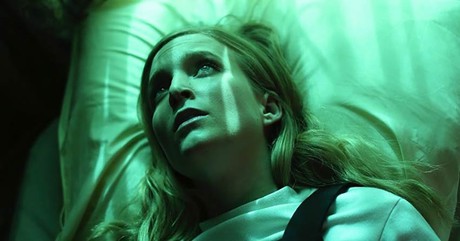
I think a lot of that came when the writer of THE TENSION EXPERIENCE, Clint Sears, came on board for a rewrite. He’s a guy I grew up with in middle school and high school and kind of knows me better than anyone, so he was able to look at the script and go “let’s add this character’s bit of development here.” Which again, five, ten years ago character development was the last thing on my mind; it was “What cool traps can I do? How can I put blood on the screen as quickly as possible?” And I think that really helped me mature as a filmmaker, as well, in trying to take my time and hopefully get to know the characters a little bit more.
ME: Excellent. One more question about this particular project: Really strong female characters. But what we saw, as is the case with Mother Superior, strength can be wielded for evil. How important was it for you to work on this project with these very strong female characters?
DLB: Very much so. And if you go back and take a look at my career, the majority of films that I’ve done, outside of THE BARRENS (2012), have females as the central character or lead. The SAW franchise, particularly SAW III, which I think is my favorite of my films, it’s all about Amanda. REPO! [THE GENETIC OPERA], it’s all about Shilo. MOTHER’S DAY, it’s all about Rebecca De Mornay’s Mother. I just did this show called “Crow’s Blood” in Japan for Hulu; all female cast. So for me I think it’s extremely important. Also, personally, my wife is absolutely terrifying. She keeps me down like nobody has and calls me out on my bullshit like nobody has. And, also, I’m sick of seeing the same thing, so for me I think there’s something more dynamic and something more challenging about trying to do something like this as opposed to having the same movie done with a bunch of dudes. About the time that this movie was being made, there was a huge thing in the news with politicians trying to tell women what they could and couldn’t do with their bodies. You had a chauvinistic man in power who was [perpetuating ideas] basically not that different from what happens in the movie. “No, Planned Parenthood can’t do this. Women can’t do this.” It was kind of disgusting. You saw these women’s marches; I saw my wife going on these women’s marches. And so I think it was a really timely tale about this woman in the 1950s that was shunned by society because she was a single, pregnant woman and she had to go into isolation to have this baby so as not to be judged. And I thought that was a really powerful message and it was humbling to be a part of so many talented female actresses and producers. One of the writers was female (Sara Sometti Michaels). One of the main producers was female (Tara Ansley). So it was kind of a humbling, cool experience to be able to watch and learn from them.
ME: Nice. Well, I guess the last thing would be do you have any final thoughts on the film? It’s release, anything you want to add, or anything you’re working on next?
DLB: Yeah, I’ve got a new movie coming out with Maggie Q and Luke Hemsworth called THE DEATH OF ME; I’m just finishing that right now. I recommend everyone check out ST. AGATHA in the meantime. It comes out On Demand and in theaters Friday, February 8th. Give it a look and witness the birth of a new, great iconic villain in Mother Superior.
ME: Great. Well, I really appreciate your time today.
DLB: Thank you so much for talking to me today. It was great speaking with you.
Check out the trailer for ST. AGATHA here.
Having seen the film, I can assure you: yes, it does happen. We’re gonna cut out tongues and strangle people with horrible objects. But it also showcases a more mature style of storytelling and knack for tension.
I guess all that experience really sunk in.
Until, next time, see you at the movies!
-McEric, aka Eric McClanahan-
